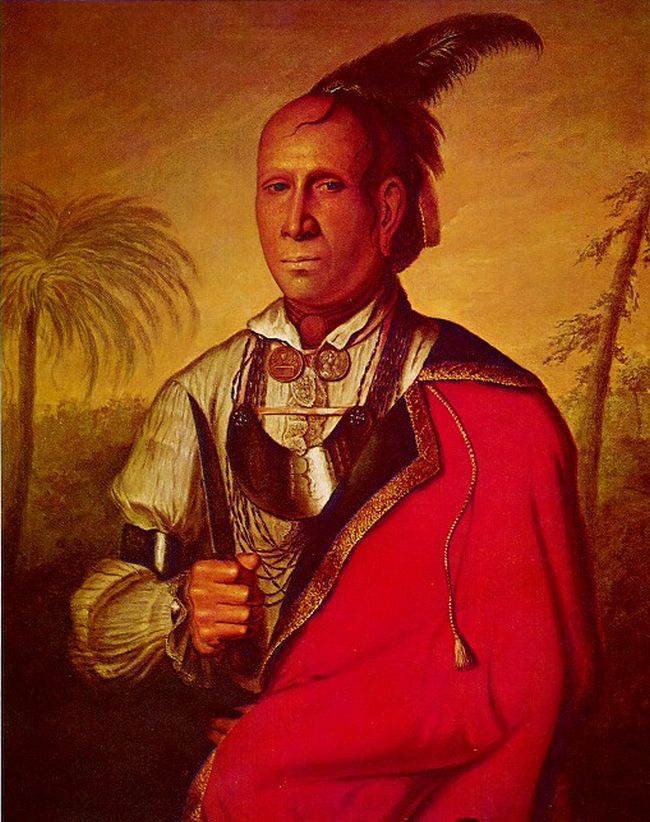|
Big Tiger
Big Tiger was Principal Chief of the council of a dissident group of Cherokee (1824–1828) who followed the teachings of Whitepath (or ''Nunnahitsunega''), a full-blood traditionalist leader and member of the Cherokee National Council who lived at Turnip Town (''Ulunyi''), on the Large Ellijay (''Elatseyi'').McLoughlin, p. 392 Background Influenced by the teachings of the Seneca prophet Handsome Lake, Whitepath began a rebellion against the acculturation then taking place in the Cherokee Nation The Cherokee Nation (Cherokee: ᏣᎳᎩᎯ ᎠᏰᎵ ''Tsalagihi Ayeli'' or ᏣᎳᎩᏰᎵ ''Tsalagiyehli''), also known as the Cherokee Nation of Oklahoma, is the largest of three Cherokee federally recognized tribes in the United States. It ..., proposing the rejection of Christianity and the new Cherokee national constitution, and a return to the old tribal laws. The "rebellion" ended with the submission of Whitepath to the more progressive members of the Cherokee National C ... [...More Info...] [...Related Items...] OR: [Wikipedia] [Google] [Baidu] |
Principal Chiefs Of The Cherokee
Principal Chief is today the title of the chief executives of the Cherokee Nation, of the Eastern Band of Cherokee Indians, and of the United Keetoowah Band of Cherokee Indians, the three federally recognized tribes of Cherokee. In the eighteenth century, when the people were primarily organized by clans and towns, they would appoint a leader for negotiations with the Europeans. They called him ''Uku'', or "First Beloved Man". The title of "Principal Chief" was created in 1794, when the Cherokee began to formalize a more centralized political structure. They founded the original Cherokee Nation. The Cherokee Nation–East adopted a written constitution in 1827, creating a government with three branches: legislative, executive, and judicial. The Principal Chief was elected by the National Council, which was the legislature of the Nation. The Cherokee Nation–West adopted a similar constitution in 1833. In 1839 most of the reunited nation was reunited in Indian Territory, after f ... [...More Info...] [...Related Items...] OR: [Wikipedia] [Google] [Baidu] |
Ellijay River
The Ellijay River is a U.S. Geological Survey. National Hydrography Dataset high-resolution flowline dataThe National Map , accessed April 27, 2011 river in Georgia. It ends in the town of Ellijay at its confluence with the Cartecay River, forming the Coosawattee River The Coosawattee River is a U.S. Geological Survey. National Hydrography Dataset high-resolution flowline dataThe National Map, accessed April 27, 2011 river located in northwestern Georgia, United States. Description The river is noted as beg ... in Gilmer County. See also * List of rivers of Georgia References * *USGS Hydrologic Unit Map - State of Georgia (1974) Rivers of Georgia (U.S. state) Rivers of Gilmer County, Georgia {{GeorgiaUS-river-stub ... [...More Info...] [...Related Items...] OR: [Wikipedia] [Google] [Baidu] |
Seneca Nation
The Seneca Nation of Indians is a federally recognized Seneca tribe based in western New York. They are one of three federally recognized Seneca entities in the United States, the others being the Tonawanda Band of Seneca (also in western New York) and the Seneca-Cayuga Nation of Oklahoma. Some Seneca also live with other Iroquois peoples on the Six Nations of the Grand River in Ontario. The Seneca Nation has three reservations, two of which are occupied: Cattaraugus Reservation, Allegany Indian Reservation, and the mostly unpopulated Oil Springs Reservation. It has two alternating capitals on the two occupied reservations: Irving at Cattaraugus Reservation, and Jimerson Town near Salamanca on the Allegany Reservation."New York Casinos." ''500 Nations.'' (retrieved 31 May 2010) A fourth territory ''de facto'' governed by th ... [...More Info...] [...Related Items...] OR: [Wikipedia] [Google] [Baidu] |
Handsome Lake
Handsome Lake (Cayuga language: Sganyadái:yo, Seneca language: Sganyodaiyo) (Θkanyatararí•yau• in Tuscarora) (1735 – 10 August 1815) was a Seneca religious leader of the Iroquois people. He was a half-brother to Cornplanter, a Seneca war chief. Handsome Lake, a leader and prophet, played a major role in reviving traditional religion among the Haudenosaunee (People of the Longhouse), or Six Nations Iroquois Confederacy. He preached a message that combined traditional Haudenosaunee religious beliefs with a revised code meant to revive traditional consciousness to the Haudenosaunee after a long period of cultural disintegration following colonization. This message was eventually published as the " Code of Handsome Lake" and is still practiced today. Early life Handsome Lake was born as Hadawa'ko ("Shaking Snow") around 1735 in the Seneca village of Canawaugus, on the Genesee River near present-day Avon, New York. Very little is known of his parents; his mother, Gahonnone ... [...More Info...] [...Related Items...] OR: [Wikipedia] [Google] [Baidu] |
Cherokee Nation (19th Century)
The Cherokee Nation (Cherokee: ᏣᎳᎩᎯ ᎠᏰᎵ ''Tsalagihi Ayeli'' or ᏣᎳᎩᏰᎵ ''Tsalagiyehli''), also known as the Cherokee Nation of Oklahoma, is the largest of three Cherokee federally recognized tribes in the United States. It was established in the 20th century and includes people descended from members of the Old Cherokee Nation who relocated, due to increasing pressure, from the Southeast to Indian Territory and Cherokee who were forced to relocate on the Trail of Tears. The tribe also includes descendants of Cherokee Freedmen, Absentee Shawnee, and Natchez Nation. As of 2021, over 400,000 people were enrolled in the Cherokee Nation. Headquartered in Tahlequah, Oklahoma, the Cherokee Nation has a reservation spanning 14 counties in the northeastern corner of Oklahoma. These are Adair, Cherokee, Craig, Delaware, Mayes, McIntosh, Muskogee, Nowata, Ottawa, Rogers, Sequoyah, Tulsa, Wagoner, and Washington counties. History Late 18th century through 19 ... [...More Info...] [...Related Items...] OR: [Wikipedia] [Google] [Baidu] |
William G
William is a male given name of Germanic origin.Hanks, Hardcastle and Hodges, ''Oxford Dictionary of First Names'', Oxford University Press, 2nd edition, , p. 276. It became very popular in the English language after the Norman conquest of England in 1066,All Things William"Meaning & Origin of the Name"/ref> and remained so throughout the Middle Ages and into the modern era. It is sometimes abbreviated "Wm." Shortened familiar versions in English include Will, Wills, Willy, Willie, Bill, and Billy. A common Irish form is Liam. Scottish diminutives include Wull, Willie or Wullie (as in Oor Wullie or the play ''Douglas''). Female forms are Willa, Willemina, Wilma and Wilhelmina. Etymology William is related to the given name ''Wilhelm'' (cf. Proto-Germanic ᚹᛁᛚᛃᚨᚺᛖᛚᛗᚨᛉ, ''*Wiljahelmaz'' > German ''Wilhelm'' and Old Norse ᚢᛁᛚᛋᛅᚼᛅᛚᛘᛅᛋ, ''Vilhjálmr''). By regular sound changes, the native, inherited English form of the name shoul ... [...More Info...] [...Related Items...] OR: [Wikipedia] [Google] [Baidu] |
Year Of Death Missing
A year or annus is the orbital period of a planetary body, for example, the Earth, moving in its orbit around the Sun. Due to the Earth's axial tilt, the course of a year sees the passing of the seasons, marked by change in weather, the hours of daylight, and, consequently, vegetation and soil fertility. In temperate and subpolar regions around the planet, four seasons are generally recognized: spring, summer, autumn and winter. In tropical and subtropical regions, several geographical sectors do not present defined seasons; but in the seasonal tropics, the annual wet and dry seasons are recognized and tracked. A calendar year is an approximation of the number of days of the Earth's orbital period, as counted in a given calendar. The Gregorian calendar, or modern calendar, presents its calendar year to be either a common year of 365 days or a leap year of 366 days, as do the Julian calendars. For the Gregorian calendar, the average length of the calendar year (the me ... [...More Info...] [...Related Items...] OR: [Wikipedia] [Google] [Baidu] |
Year Of Birth Missing
A year or annus is the orbital period of a planetary body, for example, the Earth, moving in its orbit around the Sun. Due to the Earth's axial tilt, the course of a year sees the passing of the seasons, marked by change in weather, the hours of daylight, and, consequently, vegetation and soil fertility. In temperate and subpolar regions around the planet, four seasons are generally recognized: spring, summer, autumn and winter. In tropical and subtropical regions, several geographical sectors do not present defined seasons; but in the seasonal tropics, the annual wet and dry seasons are recognized and tracked. A calendar year is an approximation of the number of days of the Earth's orbital period, as counted in a given calendar. The Gregorian calendar, or modern calendar, presents its calendar year to be either a common year of 365 days or a leap year of 366 days, as do the Julian calendars. For the Gregorian calendar, the average length of the calendar year (the mea ... [...More Info...] [...Related Items...] OR: [Wikipedia] [Google] [Baidu] |



